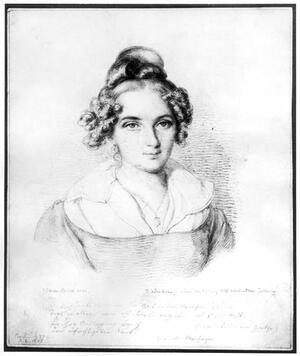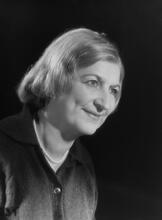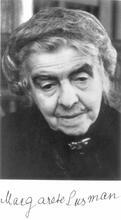Rahel Levin Varnhagen
Rahel Levin Varnhagen was the first Jewish woman to establish herself as an important intellectual and political figure in a German culture dominated by Christianity. She Is remembered in Jewish history as one of a handful of Jewish women who ran salons in Central Europe. Having converted to Christianity to marry her husband, Karl August Varnhagen von Ense, she found being a Jew a heavy burden in Enlightenment Europe but still valued her Jewish birth. Though her letters, she created a new way of writing, prompting a heterogeneous group of people to produce something together. Her way of writing was dialogical; she wrote to and together with her addressees.
A Complex Jewish Identity
The daughter of merchant-banker Levin Markus (Löb Cohen, 1723–1790) and Chaie Levin Markus (d. 1809), Rahel Levin Varnhagen (b. Berlin, May 19, 1771; d. Berlin, March 7, 1833) was the first Jewish woman to establish herself as an important intellectual and political figure in a German culture dominated by Christianity. She used her excluded status as an opportunity: “One is not free if one must represent something in the bourgeois society, a spouse, the wife of a civil servant etc,” she wrote to Pauline Wiesel, also an outcast, but for different reasons.
Varnhagen is remembered in Jewish history as one of a handful of Jewish women who ran intellectual salons in Central Europe, especially Berlin, beginning in the relatively liberal period before the defeat of Napoleon. Like many of the salonières, she converted to Christianity in preparation for her marriage to Karl August Varnhagen von Ense. Although she did not reflect much upon her Jewishness in her writings, there is one comment in a letter of 1795 to her friend David Veit:
I have a strange fancy: it is as if some supramundane being, just as I was thrust into this world, plunged these words with a dagger into my heart: “Yes, have sensibility, see the world as few see it, be great and noble, nor can I take from you the faculty of eternally thinking. But I add one thing more: be a Jewess!” And now my life is a slow bleeding to death. By keeping still I can delay it. Every movement is an attempt to staunch it—new death; and immobility is possible for me only in death itself. … I can, if you will, derive every evil, every misfortune, every vexation from that. … I shall never accept that I am a schlemiel and a Jewess.
Rahel Varnhagen’s remarks reveal her sense at the heavy burden of being born a Jew in Enlightenment Europe.
A later remark shows that she valued her Jewish birth: “What for a long period of my life has been the source of my greatest shame, my most bitter grief and misfortune—to be born a Jewess—I would not at any price now wish to miss,” was conveyed by her husband after her death.
A New Way of Writing
What is perhaps most astonishing about Varnhagen is that she created a new way of writing. She was not the only woman who concentrated on epistolary writing, but from the outset she was aware of the particular implications of letter-writing and worked to establish a network of people who would self-consciously engage in this practice as a common enterprise. In contrast to the notions of authorship that appeared in Europe around 1800, which anchored writing in the exceptional individual, here a heterogeneous group of people produced something together.
And yet a break with established genres always brings its own risks. Authors who write books can be relatively confident that their work will be preserved in libraries. Those who write letters, on the other hand, are prey to all the vicissitudes of their dispersal. Sooner or later, letters tend to get lost. A historical vulnerability is built into the form, and so Rahel Levin Varnhagen had to develop a strategy to prevent these texts from disappearing. Already in her early twenties she collected and kept all the letters she received. In 1800, before she left for Paris, where she stayed for several months, she asked a Jewish woman friend not only to tend to this collection, should she die, but also to try to retrieve from their various addressees all the letters that she had herself written. This is an indication of how extremely seriously she took this particular form of writing and collecting.
Innovative Publishing
Her new strategy forced her to confront another problem, since she wanted not only to preserve all this ephemeral material but was concerned to publish it. As early as 1812 she began a long series of epistolary publications in different journals, following two contradictory organizational principles. The first project was a dialog in which she engaged together with Karl August Varnhagen von Ense (1785–1858), whom she married on September 27, 1814—two days after her conversion to Protestantism, when she took the name Antonie Friederike. From their correspondence, they selected those remarks that concerned Goethe’s work and arranged them as a montage. Later publications show a different structure, in which only Rahel Levin Varnhagen speaks. The replies are not part of the printed dialog.
The couple lived in Vienna, Frankfurt am Main and Karlsruhe before moving back to Berlin in 1819. They had no children. Rahel had four siblings: Marcus Robert-Tornow (born Mordechai Levin, 1772–1826), a banker; Ludwig Robert (born Liepmann Levin, 1778–1846), a writer; Rose Asser (née Levin, 1781–1853) and Moritz Robert-Tornow (born Meier Levin, 1785–1846), a merchant.
Another ambitious enterprise undertaken by the couple would wait for publication until a few months after Rahel Varnhagen’s death: Rahel. Ein Buch des Andenkens für ihre Freunde (Rahel: A Commemoration for Her Friends). In the summer of 1833, Karl August Varnhagen published a one-volume edition; a year later he had collected so many of his late wife’s letters that he was able to expand the edition into three volumes. During Rahel’s lifetime, her letters to and from David Veit (1771–1814), Alexander von der Marwitz (1746–1819), and Regina Frohberg (born Rebecca Saling, married Friedländer, 1782–1850) were prepared for publication. Karl August Varnhagen also brought to press a collection of letters to his wife. Thus, many books were planned and prepared for publication, but only some of them appeared during the second half of the nineteenth century. The Sammlung Varnhagen, the collection of manuscripts Rahel Levin had started as a young woman, contains much more, including letters from famous countesses, her unknown cook, important politicians, and unestablished writers. She was in contact with more than 300 people and her archive contains some 6000 letters. Everybody is to be found there: actresses and philosophers, acculturated Jewish women and young intellectuals. We also find diaries, not written in the style of a journal, but rather Denktagebücher, or “diaries of thought,” and—last but not least—another expanded version of the Buch des Andenkens, in manuscript form, of almost 5000 pages. This archive could be seen as Rahel Levin Varnhagen’s “work,” but how does one read an archive?
Rahel Varnhagen’s Thought
What we find in these letters and aphorisms is as exciting as the story of their creation and transmission. Rahel Levin Varnhagen thought in a way that cannot be easily integrated into given genre categories. It is clear that she was never drawn to narrative or poetic writing. Hers was a special kind of thinking that did not move within disciplinary boundaries and established fields of knowledge. “I do not have a stored-up stock of thoughts,” she once wrote. A special moment, a conversation, a book, or anything else might serve as the source of her productivity. And so, she developed an entire world of insights into philosophy and music, literature and politics. Since what was relevant to her was not the result of thinking but rather the movement of thoughts, her friendships and convivial gatherings were of greatest importance to her. Both were seen as political and philosophical enterprises.
Only recently has this unusual “work” been understood to have theoretical relevance. In former times it was biography that kept Rahel Levin Varnhagen’s name alive. Letters were felt to come directly from the heart of the writer and only biography seemed to be able to arrange the fragments of letters and those of a life into a whole. This is why the theoretical richness of Rahel Levin Varnhagen’s “work” still awaits discovery. But for new ways of reading, one also will need new ways of editing this writing: annotated editions which can show the complex network she wove. The Edition Rahel Levin Varnhagen follows the structure of the archive and even when Rahel Levin Varnhagen’s letters have not survived, it presents exclusively the dialogic form.
Selected Writing by Rahel Levin Varnhagen
Collections of Letters and Diary Entries
Varnhagen, Karl August. Rahel. Ein Buch des Andenkens für ihre Freunde, 1 vol. Berlin: Trowitzsch, 1833; 3 vols. Berlin: Duncker & Humblot, 1834. 6 vols. Göttingen: Wallstein, 2011.
Varnhagen, Karl August. Galerie von Bildnissen aus Rahel’s Umgang und Briefwechsel. 2 vols. Leipzig: Reichenbach, 1836.
Assing, Ludmilla. Briefwechsel zwischen Rahel und David Veit, 2 vols. Leipzig: F.A. Brockhaus, 1861.
Assing, Ludmilla. Briefwechsel zwischen Varnhagen und Rahel, 6 vol. Leipzig: Brockhaus, 1874/75.
Assing, Ludmilla. Aus Rahel’s Herzensleben, Briefe und Tagebuchblätter. Leipzig: Brockhaus, 1877.
Meissner, Heinrich. Rahel und Alexander von der Marwitz in ihren Briefen. Ein Bild aus der Zeit der Romantiker. Gotha/Stuttgart: F.A. Perthes, 1925.
Feilchenfeldt, Konrad, et al., eds. Rahel-Bibliothek. Rahel Varnhagen, Gesammelte Werke. 10 vols. München: Matthes & Seitz, 1983.
de Bruyn, Günter. Rahels erste Liebe. Rahel Levin und Karl Graf von Finckenstein in ihren Briefen. Berlin: Buchverlag Der Morgen, 1985.
Hertz, Deborah. Briefe an eine Freundin. Rahel Varnhagen an Rebecca Friedländer. Köln: Kiepenheuer & Witsch,1988.
Hahn, Barbara, and Ursula Isselstein, eds. Edition Rahel Levin Varnhagen: Briefwechsel mit Pauline Wiesel. München: Beck, 1997.
Briefwechsel mit Ludwig Robert. München: Beck, 2001.
Familienbriefe. München: Beck, 2009.
Tagebücher und Aufzeichnungen. Göttingen: Wallstein, 2018.
Briefwechsel mit Jugendfreundinnen. Göttingen: Wallstein, 2021.
Arendt, Hannah. Rahel Varnhagen: Das Leben einer deutschen Jüdin / The Life of a Jewish Woman. Ed. by Barbara Hahn. Göttingen: Wallstein, 2021.
Hahn, Barbara. “Antworten Sie mir!”: Rahel Levin Varnhagens Briefwechsel. Frankfurt/Main: Stroemfeld/Roter Stern, 1990.
Hertz, Deborah. Jewish High Society in Old Regime Berlin. New Haven and London: Yale University Press, 1988.
Isselstein, Ursula. Der Text aus meinem Herzen: Studien zu Rahel Levin Varnhagen. Torino: Tirrenia Stampatori, 1993.
Thomann Tewarson, Heidi. Rahel Varnhagen: The Life and Work of a German Jewish Intellectual. Lincoln, Nebraska: University of Nebraska Press, 1998.






